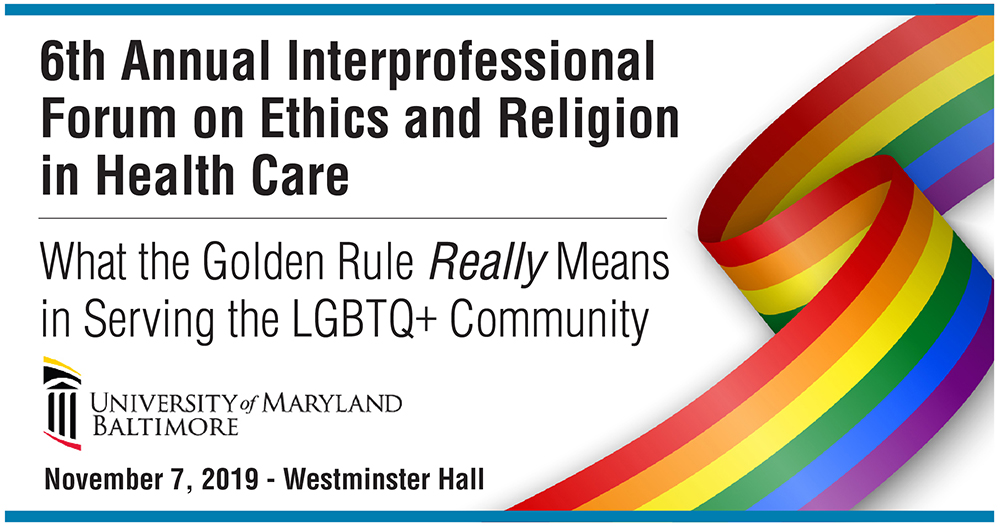
2019 Conference
Presented by:
- Living Legacy Foundation
- University of Maryland Graduate School
- University of Maryland School of Medicine
- University of Maryland Nursing
- University of Maryland Pharmacy
- University of Maryland Social Work
- Maryland Healthcare Ethics Committee Network at Maryland Carey Law
Sixth Annual Interprofessional Forum on Ethics and Religion in Health Care
What the Golden Rule Really Means in Serving the LGBTQ+ Community
Thursday, Nov. 7, 2019
University of Maryland, Baltimore
Westminster Hall
519 W Fayette St.
Baltimore, MD 21201
Gender identity, sexual orientation, and spirituality each play a part in forming our sense of self, our core values, and how we define community. Historically, health care systems and organized religions have not made efforts to identify the special needs of LGBTQ+ individuals and accommodate them, whether due to ignorance or bias. In this unique forum, we explore what the Golden Rule mandates in meeting ethical duties to promote well-being and "do no harm" for LGBTQ+ individuals seeking health care services. We welcome health care providers, ethics committee members, members of faith communities, and anyone interested in serving as an ally for the LGBTQ+ community as we explore ethical issues related to access and inclusion in health care delivery.
This event has concluded.
Conference Objectives
At the end of this conference, learners will be able to:
- Identify health care access and delivery disparities experience by LGBTQ+ individuals
- Discuss ethical issues that arise in caring for LGBTQ+ individuals
- Discuss the characteristics and advantages of interprofessional collaboration in providing care in the LGBTQ+ community
- Explore how acceptance or rejection of an individual’s LGBTQ+ identity plays out in spiritual and religious practice and implications involved
Agenda
| Time | Details |
|---|---|
| 8:30-9 a.m. | Registration/Continental Breakfast |
| 9-9:05 a.m. |
Program Details and Providing a Safe Space
|
| 9:05-9:15 a.m. |
Welcome and Opening Remarks
|
| 9:15-10 a.m. |
The Intersection of Sexuality, Gender and Spirituality
|
| 10-10:45 a.m. |
Meeting Health Needs of the Transgender Community
|
| 10:45-11:15 a.m. |
Open Mic
Anita J. Tarzian, PhD, RN |
| 11:15-11:30 a.m. | Break |
| 11:30 a.m.-12:30 p.m. |
Interprofessional Panel
Patricia Franklin, PhD, RN
Whitney Burton, MSW, MPH, CPH
|
| 12:30-1:30 p.m. | Lunch and Poster Sessions |
| 1:30-2:15 p.m. |
Intersections of Faith and Health Care for LGBTQ+ Individuals and Communities
Ahleah Gavin, PhD
Rabbi Ariana Katz
Reverend Da |
| 2:15-2:45 p.m. | Open Mic |
| 2:45-3:30 p.m. |
Intersections of Ethics and Healthcare for LGBTQ+ individuals Darren J. Freeman-Coppadge Anita J. Tarzian |
| 3:30 p.m. | Closing Thoughts and Adjournment |
Poster Presentations
Click the poster title to read the abstract.
1. Building a Foundation of Acceptance and Advocacy
Allison Agnew and Sara Groff, MSN, RN-BC, CMSRN
2. Creating an Effective LGBTQ+ Employee Resource Group
Rachel Moseley, MS, BSN, CWON, APHN; Karen Jones, MA, CDF; and Paula Teague, DMin, MBA
3. Do our gender data fields follow the golden rule within the EHR?
Cynthia L. Miller, RN
4. Improving Knowledge and Attitudes Toward Lesbian, Gay, Bisexual, and Transgender Patients Through Interdisciplinary Cultural Competency Training
Teresa Kostelec, MSN, RN, CEN
5. It takes a Village to Use the Correct Name
Pam Reifinger, EdD and Darla Marks, MSN, RN
6. LGBTQ Military Servicemembers' Experiences with Stress, Outness, Discrimination, Health, and Social Support
Pedro N. Oblea, PhD
7. Faith Leaders in HIV Outreach, LGBTQ+ Identifying Individuals, and Stigma
Mary G. DeGrezia, PhD, RN, ACR
8. Transgender Care and the Electronic Health Record - How a Transgender Clinic Transformed an Entire Healthcare System
Michele E. Farley, MLS, BSN, RN; Kristopher Elkins, MSN, RN; and Christina Cook, BSN, RN
9. Transgender Allies: Creating an Authentic Health Care Experience Through Simulation
Nasreen Bahreman, MSN, RN; Sandy Swoboda, MS, RN, FCCM; Tannaz Motevalli, BFA; and Jacob Oates, BSN, RN, ACRN
Building a Foundation of Acceptance and Advocacy
Allison Agnew and Sara Groff, MSN, RN-BC, CMSRN
At MedStar Washington Hospital Center (MWHC), our patients are the first priority in everything we do. In recent years, we have made significant efforts to create a culturally congruent infrastructure for the LGBTQ+ community.
Since 2015, MWHC has participated in the Human Rights Campaign's annual Healthcare Equality Index Assessment. Each year we use our results as a gap analysis to identify areas of improvement to ensure the provision of exceptional health care for all, especially those in the LGBTQ+ community. A Healthcare Equality Task Force was formed in 2016 to address key areas for improvement and continues to drive work for inclusive healthcare forward.
MWHC's 3 Pronged Approach to Quality Improvement for the LGBTQIA+ Individual:
1) Organizational Core Values: Emphasized MWHC's commitment to treat everyone with honor and respect at a system-wide level through the development of an "Our Pledge" video. The video includes a group of diverse associates, ranging from executive leadership to front-line staff, and was shared across the entire organization. It was then incorporated into the hospital President's monthly "My Huddle" video to demonstrate leadership's support and create a culture that embraces diversity.
2) Education: As of March 2019, began providing mandatory in-person LGBTQ+ sensitivity training, which will be for every employee, including executive leaders and clinical providers. All outpatient practices have completed trainings (50+), and inpatient and ancillary departments are scheduled to begin training in October 2019. The purpose is to educate our associates on being culturally competent in serving the LGBTQ+ community.
3) Creating a Welcoming Environment: Developed tools and resources for staff, patients and visitors:
- Updated unisex bathroom signage to "All Gender Restroom" throughout the facility in 2019
- "Your Quick Guide to Sexual Orientation & Gender Identity Communications" reference sheet covering terminology, communication tips, and additional resources in 2018.
- Added gender identity, birth sex, preferred name and pronouns to EMR's social history intake in June 2018.
As we approach 2020 we have started examining how both informatics and advances in technology although mostly beneficial, can create barriers for staff interaction with transgender and gender nonconforming patients. This is an ongoing issue; however, our mandatory training has helped to accommodate patients' needs as we continue to work towards eliminating these barriers.
Failure in addressing the special needs of LGBTQ+ individuals will indirectly cause harm on how welcome and inclusive your organization is. The Healthcare Equality Task Force constantly allows themselves to take blinders off and look at the bigger picture. The Healthcare Equality Index assessment continues to provide us with an annual pulse check on our gap analysis. Even though we consistently score high (95 out of 100 in 2019), we want to gauge the impact and meaning behind our scores as we move forward. By dissecting the annual assessment, we can continuously strive for improvement and provide a safe and inclusive environment for all.
Creating an Effective LGBTQ+ Employee Resource Group
Rachel Moseley, MS, BSN, CWON, APHN; Karen Jones, MA, CDF; and Paula Teague, DMin, MBA
Employee Resource Groups (ERGs) are groups that are led by employees in an effort to create a diverse and inclusive work environment. In our experience, there are four keys for creating and sustaining an effective LGBTQ+ ERG.
First, recognize and support synergy with the people involved, At Johns Hopkins Bayview Medical Center (JHBMC), a small group of Lesbian, Gay, Bisexual, Transgender and Queer employees met for informal monthly lunches from 2014-2017. This group felt that there was a role for a more structured ERG. The initial goal was to create a safe space for LGBTQ employees and allies to meet and discuss challenges and opportunities for growth. Johns Hopkins University and Medicine have historically had LGBTQ groups, but these were largely social in nature.
Second, align goals with the organizational values and mission. Successful ERGs improve morale and employee engagement and help create larger cultures of inclusivity (1).
In 2017, the following mission and vision statements were created with input from the Johns Hopkins Medicine Office of Diversity and Inclusion.
Vision Statement: The Lesbian, Gay, Bisexual, Transgendered, Queer and Ally (LGBT+) Employee Resource Group envisions a collaborative and compassionate healthcare setting and workplace environment free of discrimination in all forms and which promotes social justice inspires community engagement and equality for all.
Mission Statement:
The Lesbian, Gay, Bisexual and Transgender, Queer and Ally (LGBT+) Employee Resource Group (ERG) at Johns Hopkins Bayview Medical Center is committed to diversity and inclusion within our workforce and in our interactions with our patients, clients and community
Third, endorsement from executive leadership (2). The LGBTQ+ ERG has monthly breakfast meetings funded by the JHBMC President. There is an executive champion for the ERG as well as connection to leadership in the Diversity and Inclusion Council from JHBMC.
Fourth, structure the ERG meetings and initiatives. A typical meeting for the ERG consists of introductions, everyone sharing "a good thing" with the group and a presentation by a group member and planning for educational events. This structure allows for building a sense of community while improving patient experience.
Annually, the ERG participates in Baltimore Pride Festival and Pride Parade. An educational Pride lecture is held for the institution. These presentations have become increasingly well attended with the greater visibility of the group and the desire to provide enhanced care for our patients. The ERG has participated in "Ethics for Lunch" sessions, the annual Diversity Fair and held an Open House dinner for those employees with friends or family members who identify as LGBTQ. The group has established an intranet site with upcoming events and resource links as well as a closed-group Facebook page for increased communication.
Those who participate in the group voice that there is increased sense of community as well as the desire to continue educating others in the formation of a more inclusive workspace for both staff and patients. This dynamic group continues to grow, thrive and strive for equality for all.
Do our gender data fields follow the golden rule within the EHR?
Cynthia L. Miller, RN
Within the Electronic Health Record (EHR), there are multiple Gender Identity fields which are just as diverse and misunderstood as the patients they represent. The Administrative Sex field has historically been used to perform clinical checking and to dynamically drive gender related history questions. According to ecqi.heatlhcare.gov (Electronic Clinical Quality Improvement), Administrative Sex is defined as "representing gender identity". Clearly, this is not the field to be driving clinical decision making.
Regardless of the status of the patient's current clinical gender assignment or their self-defined gender identity, the patient's genetic gender remains irrevocably defined by an XX or XY chromosome. Physiological parameters should be based on the XX or XY defined parameters. As an example, drug dosage recommendations for Ambien have genetic gender considerations. Glomular filtration rates (GFr) have reference ranges flexed by gender and age.
A case in point, a patient who self identifies as male may in fact be pregnant. Unless clinical checking is based upon genetic gender (based on the XX or XY reality), all pregnancy related drug checking provided by an EHR could be missed.
Rules that drive the collection of gender histories based off sex fields should be removed. All gender fields should be available to the clinician for all patients equally. Transgendered males may have gravida, para histories. Transgendered females may need prostate exams as well as recommended mammography requirements. The electronic record can help by scripting these clinically pertinent questions to the provider.
Education and sensitivity training are needed to address these changes and are currently lacking in the medical community. The US Department of Justice clearly states that the patient has the right to be addressed by their preferred pronoun. However, few EHR's display this information within the patient identification banner at the top of the record. This information should be clearly visible to the provider who is about to see the patient. The clinician should be able to identify their patient as Mr. Dana Smith or Ms. Dana Smith prior to seeing the patient.
Conclusion- Opportunities still exist to improve the care of the LGBT patient within the EHR. Clinicians need to have a clear understanding of the various gender fields and their relevance to treatment. Informaticists should clearly understand the mapping of the gender fields and which fields are driving clinical checking. Rules that dynamically drive health related questions should be removed so that all questions are available equally to all patients regardless of their gender. Birth sex fields need to be externally interfaced or transmitted to other health care industries such as reference labs or e-prescribing facilities. Education and sensitivity training should be provided to all staff, including questions to tactfully launch or introduce the discussion with the patient.
The EHR does not currently provide the golden rule to the LGBT community. We still have work to do.
Improving knowledge and attitudes toward lesbian, gay, bisexual, and transgender patients through interdisciplinary cultural competency training
Teresa Kostelec, MSN, RN, CEN
Purpose: Discrimination of lesbian, gay, and bisexual (LGB) persons correlates with high rates of psychiatric disorders, substance abuse, and suicide. Transgender individuals have a high prevalence of victimization, suicide, and are less likely to have health insurance than cisgender individuals. The need for improvements in LGBT health disparity education is widely recognized. This study intends to evaluate emergency healthcare team members' knowledge, competency, and attitudes toward LGBT people pre and post comprehensive educational program. Investigators seek to understand the impact LGBT health disparity education has on staff members' knowledge, openness &support, and oppression awareness of LGBT patients.
Design: A pre/post intervention design assessed the differences between healthcare team members' knowledge, competency, and attitudes on LGBT communities in pre and post education intervention. Correlation design assessed the differences between healthcare team members' LGBT staff knowledge, openness &support, and oppression awareness in pre and post education intervention.
Setting: Level II urban emergency department
Participants/Subjects: A convenience sample of staff including providers, nurses, support technicians and registration clerks. All staff was invited to participate. Those who did not wish to participate were excluded. Study participants were informed about the study protocol and voluntary consent was obtained.
Methods: A pre/post intervention design gauged team members' knowledge and attitudes on the LGBT experience and oppression. A correlation design assessed differences pre and post cultural competency training. The study was approved by the hospital's Institutional Review Board. Voluntary consent was obtained from study participants. The Ally Indentify Measure (AIM) was chosen as a psychometrically sound tool and administered to a convenience sample of ED staff using online and paper formats. Data was analyzed for descriptive statistics to answer the primary research question. Team members' mean scores on the AIM measurement tool were compared pre and post intervention using independent sample t-tests. Significant statistical relationships were considered with a p < 0.05 using SPSS 17.0.
Results/Outcomes: Results of the pre and post AIM survey indicated a positive relationship between LGBT education and increased knowledge, competence, and attitudes among emergency department healthcare team members. Registered nurses accounted for 51.6 % of study participants (n=49). The vast majority of subjects were college educated 75.8% (n=72). Of note, 86.3 % of study participants had not received previous LGBT education. Only 11.5% indicated they attend school-sponsored LGBT education. Pre survey questions on LGBT knowledge & skills, openness & support, and oppression awareness showed a total index mean of 64 with a possible range of 19-95. Higher scores indicate a higher ally identity level. Post intervention survey results revealed an increased mean score of 72.5 providing a statistically significant p value of < 0.001.
Implications: Inclusive patient centered care includes all sexual orientations and gender identities. An overwhelming majority of healthcare team members have not had LGBT cultural competency training. Educating staff on LGBT health disparities may improve care delivery and patient outcomes. By measuring staff knowledge, openness &support, and oppression awareness of the LGBT experience, education opportunities can be targeted to address deficiencies and improve emergency care to this population.
It takes a Village to Use the Correct Name
Pam Reifinger, Ed.D and Darla Marks, MSN, RN
PennState Health is a multi-hospital health system that services communities located in central Pennsylvania, providing care to a diverse population. Transgender patients may have a desire to utilize a preferred name in the demographic information of their electronic health record rather than using their legal name since this group is underserved and underrepresented in the community. With this system enhancement, the PennState Health registration staff will have the ability to enter a preferred name in the registration conversation of the electronic medical record. The information that is entered in the preferred first name field will display on every page of the patient's electronic medical record via the demographic banners, reflecting how the patient prefers to be addressed. Displaying this information will assist the providers who are caring for the patient, while providing a more comfortable, safe experience for the patient.
By collecting the preferred first name, Penn State Health is reflecting the importance of how patients are addressed. PennState Health considers this a priority, and patient satisfier that demonstrates the system's commitment to diversity and inclusion. PennState Health policies will be modified to include the preferred name as a self-identifier along with the legal name, since the preferred name will be listed on the ID/armband of the patient in parentheses after the full legal name.
How can we treat each other when we are vulnerable?
The "Golden Rule" applies to every interaction that we have with one another.
There is no greater opportunity to care for someone vulnerable than when they are in need of healthcare. For example, when Chris come into the hospital for surgery, he was treated differently because his insurance cards reflected the he was born a female. Even with the knowledge that this patient was in the process of transitioning, he was called the wrong name constantly throughout his experience. Implementing the visibility of the preferred name will change this experience.
Our health system has identified the importance of respecting and valuing the needs of all patients. One of the first steps that our health system is taking is asking our patients for their preferred name and displaying it so that every member of the health care team can be aware of and acknowledge the patient by their preferred name. The health system organized a multidisciplinary committee that collaborated with not only all the entities within the health system, but also the patient adult/pediatric and clinic family advisory boards.
The preferred name will now be visible not only in the patient's electronic medical record but also on their hospital ID bracelet. The patient will have the ability to document within the patient portal using their preferred name. The multidisciplinary team is already strategizing next steps in this important initiative to improve the care our health system offers to the LGBTQ+ community.
LGBTQ Military Servicemembers' Experiences with Stress, Outness, Discrimination, Health and Social Support
Pedro N. Oblea, PhD
Purpose: Most of the published research on LGBTQ has focused on the civilian population. LGBTQ servicemembers have made profound contributions to the US military, but little is known about the associated problems they continuously face. This study examined the lived experiences, associated stressors, and social support impacting the health and readiness of LGBTQ prior military servicemembers.
Methods: This descriptive cross-sectional study was conducted on 168 LGBTQ prior military servicemembers through a convenience sampling using SurveyMonkey®. Data were collected using a valid and reliable questionnaire consisting of three sections: demographic data, a combination of survey questionnaires such as the Daily Heterosexist Experiences Questionnaire (DHEQ), Multidimensional Scale of Perceived Social Support (MSPSS), Outness Inventory (OI), Perceived Stress Scale (PSS), and RAND 36-Item Health Survey 1.0, and two open-ended questions. Collected datasets were analyzed using SAS© software version 9.4.
Results: Sociodemographic characteristics. A total of 168 participants completed the survey. A majority of the participants were 25 to 34 years of age (30%). About 84% of the participants were white, 61% were male, and 98% spoke English as their primary language. There were more married or partnered subjects (64%); among those, 51% were married or partnered to same sex, and 10% to the opposite sex. The military branches represented in this survey were the Army (45%), the Navy (23%), and the Air Force (24%). Ranks E-4 to E-6 made up 49% of the participants, followed by O1-O3 (16%). With regard to sexual orientation, 30% of study participants self-identified as lesbian, 17% as bisexual, and 32% as gay.
Healthcare experience. Of the 168 participants, 21% claimed that it was somewhat difficult or very difficult to obtain medical care while 54%, found it very easy. About 12% stated that there was a time when they needed medical care but didn't get it because of their sexual orientation; 28% have had some negative healthcare experience due to their LGBTQ status ranging from unequal treatment, disrespect from providers, verbal harassment, to denial of service. For 21% of study participants, there was at least one incident in the past year that caused them to postpone or not seek preventive care when sick or injured due to LGBTQ discrimination; some even reported not having received needed medical care as a result of the incident. Overall, 53% of participants qualified the effect of disclosing LGBTQ status to healthcare providers on their healthcare treatment as positive and 16% as negative; 33% reported having to teach their healthcare provider about LGBTQ-specific issues in order to get appropriate care.
LGBTQ policy priorities. Overall, LGBTQ military prior servicemembers identified the three most important policy areas: Protecting LGBTQ servicemembers from discrimination in work assignments (51%); DOD policies that address bullying, harassment, and hate crimes in the military (51%); and access to LGBTQ-sensitive healthcare (48%).
Conclusion: The preliminary findings offer us a glimpse of the characteristics of LGTBQ servicemembers and their likelihood of facing healthcare disparities related to their sexuality.
Faith Leaders in HIV Outreach, LGBTQ+ Identifying Individuals, & Stigma
Mary G. DeGrezia, PhD, RN, ACR
Stigmatization of people living with HIV (PLWH) is a barrier to effective HIV prevention and treatment. Causes of HIV-related stigma include fear related to lack of knowledge and/or perceived associations with what some consider immoral behaviors, including individuals whose sexual orientation is other than heterosexual and/or whose gender identity is other than cisgender. Stigmas prevent individuals from accessing needed services, support, and guidance https://www.4yana.com/138-2/ (STIGMA – YANA, 2019).
Stigmatization of LGBTQ+ individuals is extremely troubling. Cases currently being heard by the US Supreme Court include individuals fired because of their gender identity or sexual orientation (R.G. & G.R. Harris Funeral Homes v. EEOC and Aimee Stephens; Altitude Express Inc. v. Zarda, & Bostock v. Clayton County; https://www.hrc.org/blog/disgraceful-fired-because-theyre-lgbtq).
Faith leaders serve as role models for members of their faith communities and beyond, occupying a prime position to show acceptance of and thereby reduce stigma bestowed upon LGBTQ+ identifying individuals. From 2015-2018, 18 Christian, Islamic, & Jewish faith leaders (9 male & 9 female; 9 AA, 3 blended race, & 6 White, aged 30-70 years) involved in HIV outreach in the Greater Baltimore and Washington, DC areas were interviewed to learn about their experiences. The open-ended interview guide was informed by the first author's own background in faith-based HIV outreach and as a nurse listening to clients’ (primarily gay men living with HIV) faith community experiences. After having heard the necessity of inquiring about faith leaders’ experiences with LGBTQ+ identifying individuals from the first few leaders, questions concerning outreach to LGBTQ+ individuals were incorporated.
Despite widely held thoughts that traditional faith leaders are anti-LGBTQ+, faith leaders involved in HIV outreach expressed having the same feelings of love, acceptance, caring, and compassion for LGBTQ individuals as for all others in need of their assistance. However, some lay leaders and traditional faith leaders alike believed members at every level of their faith community hierarchies still have much to learn.
Transgender Care and the Electronic Health Record - How a Transgender Clinic Transformed an Entire Healthcare System
Michele E. Farley, MLS, BSN, RN; Kristopher Elkins, MSN, RN; and Christina Cook, BSN, R
Eskenazi Health operates Indiana's only transgender health and wellness clinic. Transgender health and wellness at Eskenazi Health combines primary care services, mental health services, speech therapy, legal services, surgery consultations and patient support groups. The clinic opened just prior to the implementation of a unified electronic health record (EHR) that combined more than 30 standalone systems and the EHR had few, if any, considerations for transgender patients. As a result, Eskenazi Health had to create custom, clinic-specific documentation tools to ensure safe and thorough care for our transgender patients. The creation and implementation of these tools then led to further exploration of how they might benefit patient care in all areas of the health system.
Gaps identified during implementation included lack of available sections to discretely document surgical histories related to gender confirmation, the inability to document mental health needs and health history specific to our transgender population, and registration workflows for identifying any patient's preferred name in a standard manner. These gaps created issues in continuity across patient care and capabilities with downstream systems such as automated appointment reminders.
Post implementation it was determined that the EHR software contained several gaps: organ inventories were available only based on sex assigned at birth, preferred name was not used in all patient-facing documentation, and obstetrical workflows were based on legal sex and not the patient's current biological needs. Each of these items initially appeared to be standalone issues, but with collaboration between the Information Solutions (IS) and Clinical Informatics (CI) teams, it became readily apparent that as a whole, the EHR was lacking and that an overhaul was needed.
In early 2019, the EHR was upgraded and the vendor added several documentation tools to its foundation system that were similar to the custom items Eskenazi Health had already created. This optimization gave IS and CI the opportunity to lead documentation change for the entire organization. This house-wide change included assessing all access points of the patient's chart in every part of the hospital or clinic, expanding patient-led changes through the patient portal and increasing use of preferred names over legal names where possible.
As a result of this upgrade CI and IS have been able to use this opportunity to launch house-wide documentation changes, information gathering, and education initiatives that have been clearly positive for all patients, not just those patients seen in the transgender clinic. Those efforts have led to increased awareness of patient preferences in their identity choices, including new education initiatives for both patients and staff and ongoing workgroups that focus on enhanced documentation to meet the needs of a diverse population.
Transgender Allies: Creating an authentic health care experience through simulation
Nasreen Bahreman, MSN, RN; Sandy Swoboda, MS, RN, FCCM; Tannaz Motevalli, BFA; and Jacob Oates, BSN, RN, ACRN
Interactions of health care providers are influenced by 'lived' experiences, societal and workplace pressures and sensitivity. A health care provider's personal set of values, biases, philosophy of care, workload and time constraints impact therapeutic relationships. Developing an awareness of differences and similarities, and therapeutic communication skills, allow for effectively engaging transgender individuals. This allows for understanding how their experiences in the healthcare setting affect health perceptions of these individuals. Therefore, learning how to communicate with empathy and the ability to respond to patients' verbal and nonverbal cues can go a long way in establishing rapport and a collaborative relationship with patients and their families.
Simulation provides the opportunity to expose learners to a variety of patients and to foster development of therapeutic communication with patients, irrespective of their differences. These experiences are increasingly critical for practicing in an environment where diversity is the norm, not the exception. Simulation can enhance and address issues related to transgender health.
This presentation will describe the development of a simulation scenario to highlight challenges of a transgender adolescent experiencing bullying in the school setting. We will share strategies to implement similar educational activities. The developers aimed to create the most authentic experience. To accomplish this goal, the scenario was written with insight from those identifying as transgender, simulation experts, and an experienced standardized patient who was trained to portray the patient in this simulation. Transgender people often experience discrimination, violence, and systemic maltreatment during their interactions with various health care disciplines stemming from lack of knowledge of principles of gender-affirming care. Creating an authentic experience that is gender affirming and vetted by trans experts is vital to the success of the simulation. Strategies for learner and facilitator preparation and reflective debriefing including terminology and implicit bias will be shared.
Lessons learned from the development and implementation of this scenario has led to ideas for generation of similar educational activities involving other health care disciplines. Challenges in navigating society (bullying/understanding) and the healthcare setting (terminology/Implicit bias) experienced by LGBTQ+ people are reviewed. Exposure to well vetted and thoughtfully created simulation scenarios as an IPE experience will be described. Learners have responded to this simulation by recognizing and commenting on its importance in the curriculum as a relevant topic in society today. Some learners have left the simulation with both a better understanding of LGBTQ+ people and more skills to take care of LGBTQ people in the healthcare setting.
Continuing Education
Nurses:
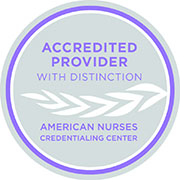
Nurses may receive 6 contact hours upon successful completion of this educational activity. Successful completion of this activity for Continuing Education (CE) requires attending the entire activity, completion of the online CE evaluation, and verification of attendance form. Partial credit is not provided. Participants receive a CE certificate via email from the University of Maryland School of Nursing approximately 2-4 weeks after submitting their request and required documentation. All requests must be received within 30 days of the conference.
The University of Maryland School of Nursing is accredited as a provider of continuing nursing education by the American Nurses Credentialing Center’s Commission on Accreditation.
Pharmacists
 The University of Maryland School of Pharmacy is accredited by the Accreditation Council for Pharmacy Education as a provider of continuing pharmacy education. This knowledge-based activity (UAN: 0025-0000-19-098-L04-P) is approved for 6.0 hours (0.6 CEU) of continuing education credit. Statements of credit will be posted to CPE Monitor within three weeks for all participants who successfully complete the activity.
The University of Maryland School of Pharmacy is accredited by the Accreditation Council for Pharmacy Education as a provider of continuing pharmacy education. This knowledge-based activity (UAN: 0025-0000-19-098-L04-P) is approved for 6.0 hours (0.6 CEU) of continuing education credit. Statements of credit will be posted to CPE Monitor within three weeks for all participants who successfully complete the activity.
Successful completion of this activity requires your signature on the sign-in sheet,
participation in the entire activity, and completion of an online activity evaluation.
Physicians: Accreditation and Credit Designation
The University of Maryland School of Medicine is accredited by the Accreditation Council for Continuing Medical Education to provide continuing medical education for physicians.
The University of Maryland School of Medicine designates this Live activity for a maximum of 6.00 AMA PRA Category 1 Credits™. Physicians should claim only the credit commensurate with the extent of their participation in the activity.
Social Work:
The University of Maryland School of Social Work Office of Continuing Professional Education is authorized by the Board of Social Work Examiners in Maryland to sponsor social work continuing education programs and maintains full responsibility for this program. This training qualifies for 5.25 Category I continuing education units. Successful completion of this activity requires your signature on the sign-in sheet, participation in the entire activity, and completion of an evaluation form to be handed in at the end of the activity. This conference does not meet the Maryland Board of Social Work’s ethics requirement.
Resources
The Institute for Innovation and Implementation
AMAZE Inclusive Sex Ed Videos for Young People
Bizic, M. R., Jeftovic, M., Pusica, S., Stojanovic, B., Duisin, D., Vujovic, S., … Djordjevic, M. L. (2018). Gender Dysphoria: Bioethical Aspects of Medical Treatment. BioMed research international, 2018, 9652305. doi:10.1155/2018/9652305
St. Matthew Catholic Church: LEAD Ministry (video)
VICTORY Excerpt from BLACK LOVE: The Quest for Marriage Equality (video)
National Center for Trangender Equality: About Transgender People
UMSON offers year-round opportunities for continuing education, which is now recognized for license renewal in Maryland. Take advantage of online, simulation, and in-person activities to enhance your professional development.
 Gregory Brightbill
Gregory Brightbill  Darren Freeman-Coppadge, PhD, PharmD, BCPP
Darren Freeman-Coppadge, PhD, PharmD, BCPP  Ezra Halstead, MA
Ezra Halstead, MA  Moderator:
Moderator: Moderator:
Moderator: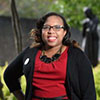 Panelists:
Panelists: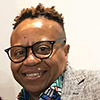 Deborah Dunn, PA
Deborah Dunn, PA Charles Xavier Kilborn
Charles Xavier Kilborn  Elyse Pine, MD
Elyse Pine, MD Moderator:
Moderator: Panelists:
Panelists: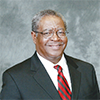 Bishop Douglas L. Miles
Bishop Douglas L. Miles Reverend Joseph L. Muth Jr.
Reverend Joseph L. Muth Jr. vid Norse Thomas
vid Norse Thomas